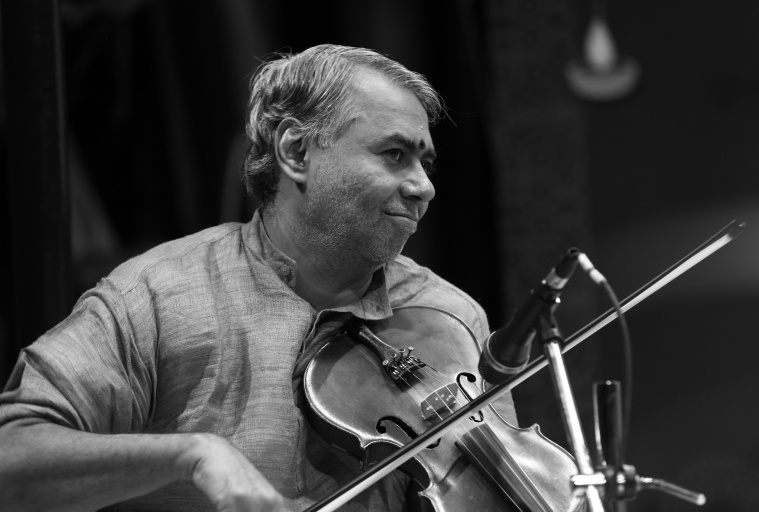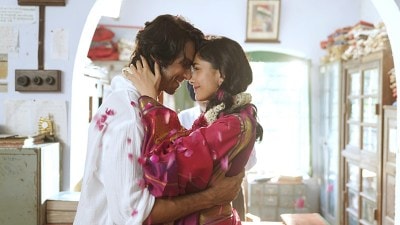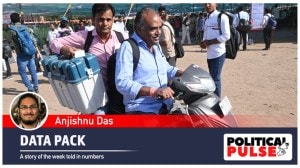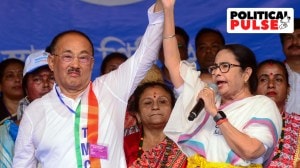- India
- International
A cool and breezy Carnatic Summer is helping Chennai reset and rehab
G Pramod Kumar finds that though it is not the famed annual season yet, but unusually there has been plenty of music in Chennai thanks to an impressive off-season line up
 Dr G Baby Sreeram (Photo credit: Rajappane Raju)
Dr G Baby Sreeram (Photo credit: Rajappane Raju)Probably the only apparent thing that a visitor to Chennai would notice this summer is that the city’s viscera is completely out in the open. Roads and streets that have been turned inside out with hugely inconvenient barricades and blocks, dust and slush, mangled underground cables, and carriageways that have been reduced to at least two-third of their width.
However, there has been a pleasant relief in the form of the city’s famous gift to the world: Carnatic music. It’s not the famed annual season yet, but unusually there has been plenty of music. The city had an impressive off-season line up this time that saw prominent names such as Sanjay Subrahmanyan, Abhishek Raghuram, Balamurali Krishna, TM Krishna, Saketharaman, Bharath Sundar, Akkarai Sisters, Amritha Murali, Vishnudev KS, Suryaprakash Ramachandran and so on along with the younger generation of singers such as Sunil Gargyan, Girijashankar Sundaresan, Kalyanapuram Aravind, Brinda Manickavasagan, Aishwarya Shankar and so on. Equally impressive was the line-up of accompanying artistes on violin, mridangam, ghatam and ganjira.
 There has been a pleasant relief in the form of the city’s famous gift to the world: Carnatic music. It’s not the famed annual season yet, but unusually there has been plenty of music. (Photo credit: Rajappane Raju)
There has been a pleasant relief in the form of the city’s famous gift to the world: Carnatic music. It’s not the famed annual season yet, but unusually there has been plenty of music. (Photo credit: Rajappane Raju)
One usually doesn’t expect a “mini-season” like this during May-September when most of the musicians turn out to be itinerant performers touring mostly Karnataka, Kerala, Mumbai and other parts of the country as well as overseas. Probably because of the long dry spell caused by the Covid pandemic, the Carnatic-friendly towns and cities in other states too had a lively summer season with cities such as Bengaluru, Mysuru and Thiruvananthapuram hosting most of the gigs.
G Pramod Kumar (@pramodsarang) finds that though it is not the famed annual season yet, but unusually there has been plenty of #music in #Chennai thanks to an impressive off-season line up. #CarnaticMusic #Vocalisthttps://t.co/Bcw32T3Peo
“We all know how terrible it was to sit at home, it almost felt like the two hands were chopped off. Such was the scenario during Covid. Performing before the cameras never felt the same way as it would be to a hall filled with people. Returning to live audiences was just the perfect way to present a concert,” said Sunil Gargyan.
Although the musicians had partially come out of their epidemiologically mandatory safe-zones and started performing in hybrid-formats (part live- part digital) end of last year, now they are fully out. Many of them also have a good overseas schedule (mostly, the US). So, this happy summer activity must be a harbinger of the return of the live Carnatic concert in its original and full-bodied form. After all, according to the WHO, an end to the pandemic is in sight.
 RK Shriramkumar (Photo credit: Rajappane Raju)
RK Shriramkumar (Photo credit: Rajappane Raju)
“When the restart button was pressed for the live concert, it was a new dawn. The internet music has changed the perspectives of listening, especially the attention span. Every moment of a concert, even the silence, is now precious time for the audience, it is left to the artiste to make those enjoyable and inclusive for both parties,” said Suryaprakash Ramachandran.

For a change, let’s talk about the accompanying artistes first.
Every time I watch violinist MA Sundaresan, who comes from an illustrious lineage, I marvel at his skills, technique, thought-processes, imagination and the sophistication of his musical wisdom. At a concert by Vishnudev KS at the Narada Gana Sabha mini hall, I was only a couple of feet away from him, watching his bow and fingers without missing a detail. I thought his violin was weeping when he played the Varali alapana. Later, I watched him again with Suryaprakash Ramachandran with whom his Purvikalyani had an unusual flavour with straighter notes, Hindustani touches and glides. When I told Suryaprakash about it, he said “Yes, Parur Style”. Watching Sundaresan up close was like savouring vintage.
Same with S Varadarajan too, who regularly plays with Sanjay Subrahmanyan. Over the years, his music has assumed a distinctive introspectiveness, the kind of calm and solemness that you see only in masters. His Simhendramadhyamam and Madhyamavathi at Sanjay’s concerts (Sanjay Sabha) and Shree at the concert by Kunnakkudi Balamurali Krishna stood out. While he accompanies the singer, the complimentary variations or occasional extra notes and gamakams he makes fire the listeners’ imagination too.
 N Guruprasad (Photo credit: Rajappane Raju)
N Guruprasad (Photo credit: Rajappane Raju)
Akkarai Subhalakshmi is somebody who can literally play anything that the vocalist sings. Watching her with two stalwarts – a highly improvisational and out-of-the-box Abhishek Raghuram and TM Krishna, that too at close quarters was a treasure. Absolute mastery over the idiom and her instrument. There was also HN Bhaskar in the same league, performing almost every day either in the city or elsewhere.
In percussion, watching this year’s Sangita Kalanidhi designate and great master Thiruvarur Bhakthavalsalam – who by himself is a school of percussion – Neyveli B Venkatesh, Arun Prakash, Vijay Natesan and B Sivaraman among others was indeed fulfilling. The diversity of their expression, sounds, or interpretation of the same rhythm systems in similar musical contexts was fascinating. Their strokes, intensity, modulation, the poise, speed, arithmetic combinations and even the overall philosophy of “laya” make each one sound so unique. The storm that a hard-hitting Thiruvarur Bhakthavalsalam and Sree Sundarkumar created at Balamurali’s concert at Narada Gana Sabha and the poetic fluidity of Arun Prakash at Thamarakkad Govindan Namboothiri’s concert at Indira Ranganathan Trust will be remembered for a long long time.
 K Arun Prakash (Photo credit: Rajappane Raju)
K Arun Prakash (Photo credit: Rajappane Raju)
Arun Prakash has always been amusing to watch, primarily because of his unusual style. Sometimes slow lone gentle strokes and long pauses, sometimes just some gumkis, and sometimes riveting grooves that accelerate like a sports car but don’t end up in full throttle. Sheer poetry in motion. Grace and aesthetics at their finest.
Neyveli B Venkatesh in Sanjay Subrahmanyan concerts is both delightful as well as a little out of the ordinary for two reasons – one, his un-acrobatic clutter-less and smooth mastery over the instrument and the other, his fondness for Sanjay and his music. While he is accompanying Sanjay’s singing or playing solo, his sole attention is on Sanjay (probably his only eye-contact) and the enthusiasm that the latter’s delightful encouragement generates is unmissable.
In the TM Krishna concert at the Mukunda Raghavendra Sundara Panduranga Mandir, B Sivaraman, one of the most understated mridangists in Chennai, displayed the art of percussion quite ornately. Probably because of his own non-flamboyant nature, his fluid strokes, arithmetic variations and “nadai changes” were deceptive, but truly artful.
Watching the big vocalists back-to-back during the summer is indeed exceptional: three full-house Sanjay Sabha concerts; an informal, but elaborate and thunderous concert by TM Krishna accompanied by Akkarai Subhalakshmi and Guruprasad (ghatam); Abhishek Raghuram accompanied by Akkarai Subhalakshmi and Patri Sathishkumar; two Balamuralikrishna concerts accompanied by Bhaskar and Varadarajan; Saktheraman accompanied by RK Shriramkumar and ghatam maestro V Suresh and so on. And there are a few more big ticket events lined up before the Navaratri season and eventually the Margazhi.
 Govindan Namboodiri. (Photo credit: Rajappane Raju)
Govindan Namboodiri. (Photo credit: Rajappane Raju)
The big bonus for me was the reclusive musician from Kerala Thamarakkad Govindan Namboodiri, who is rarely seen on concert stages. I have read somewhere the great MD Ramanathan comparing the exposition of a raga to “muzhukkappu”, the religious offering that we see in Kerala temples in which the idol is covered with sandal paste. He had said that handling a raga is like doing “muzhukkappu” – you have to do it slowly and devotedly from head to toe as a meditative process. The paste stays there for a day or so before it’s handed over to the devotee as prasadam.
While watching Thamarakkad Govindan Namboodiri sing at the Indira Ranganathan Trust (by Ganapriya and Nadabhringa Foundation), it was not MD Ramanathan that came to my mind, but his “muzhukkappu” analogy – the slow, detailed and painstaking process he’s willing to undertake to show the real swaroopam of the raga and the composition.
A composition that you have heard innumerable times suddenly starts showing soul-stirring details which you feel a little fearful to explore even as a listener. Those are precise, deeply moving – sometimes painful – details that only a renouncer can attempt. Of course we see a lot of it in the music of some of my favourites, but Thamarakkad’s music is only about such an exploration.
A never-ending allure of Chennai is how an art form is preserved over several generations in a family or community. Whether you like their idiom/style or not, you can’t help but admire their integrity towards their art. I guess it’s hard to achieve such unwavering commitment without an inter-generational gift. The ethic is something that is handed down by people who traveled before you.
“Now that the December season is around the Corner, it’s double delight that this will be the first full fledged season post the pandemic and also the one where we’d be able to see the gushing and ever-bustling rasikas throng the sabhas,” says Sunil Gargyan. “Artists like us thrive on the response and appreciation. It can be a gentle nod or a heartfelt ‘sabash’. I am happy that the live concerts are back. It really feels like a reunion. Greatly looking forward to meeting and greeting many rasikas in the December season,” adds Girijashankar Sundaresan.
Apr 25: Latest News
- 01
- 02
- 03
- 04
- 05








































